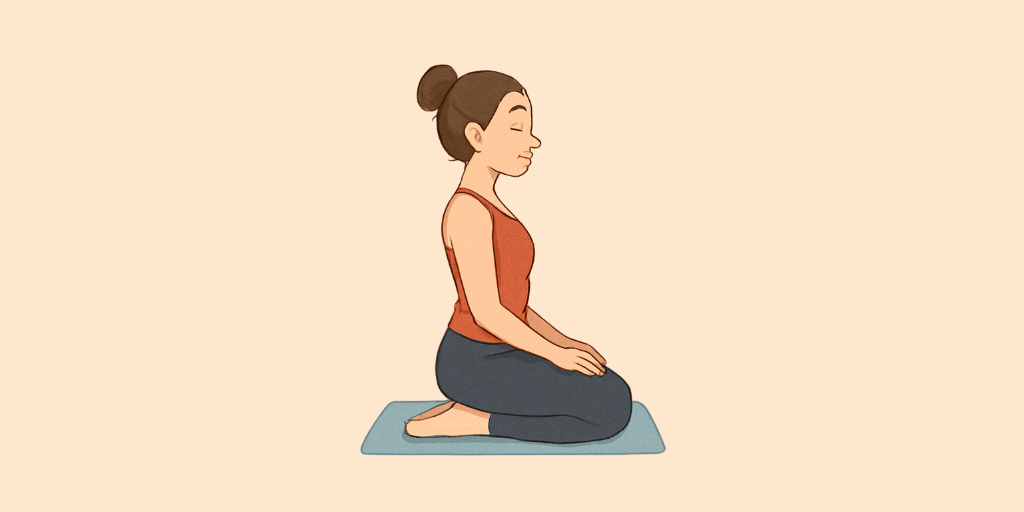Sanskrit Name: वज्रासन
English Name : Diamond Pose
Description:
Vajrasana, commonly known as Thunderbolt Pose or Diamond Pose, is a seated yoga position frequently utilized in meditation, pranayama (breathing exercises), and as a resting posture during yoga sessions. This pose is celebrated for its grounding and calming benefits.
The term “Vajra” originates from Sanskrit, meaning diamond or thunderbolt. The diamond signifies strength, permanence, and clarity, whereas the thunderbolt represents transformative power and the ability to eliminate distractions or mental chaos. The word Asana translates to pose or posture.
This asana is rooted in Hatha Yoga and Raja Yoga, where it serves as a foundational position for seated meditation. It is believed that sages and yogis practiced it to improve focus, foster patience, and sustain a steady, alert, yet relaxed posture over extended sitting periods.
Thus, Vajrasana can be interpreted as the Diamond Pose or the Thunderbolt Pose, symbolizing both its stable, grounded physical form and the mental clarity and strength it promotes. Practicing this pose is said to enhance inner stability and concentration, akin to a diamond cutting through illusion or a thunderbolt illuminating darkness.
How to Do It:
Here are the steps to do Vajrasana (Thunderbolt Pose):
-
Start in a Kneeling Position: Begin by kneeling on the floor with your knees close together and your feet flat on the floor. The tops of your feet should be touching the floor.
-
Sit Back on Your Heels: Slowly sit back on your heels, ensuring that your buttocks rest comfortably on your heels or the upper part of your legs. Keep your spine straight.
-
Place Your Hands on Your Knees: Place your palms on your knees, keeping your elbows relaxed and close to your body.
-
Maintain an Upright Posture: Keep your back straight, shoulders relaxed, and chest open. Engage your core slightly to maintain balance and posture.
-
Focus on Your Breathing: Close your eyes if comfortable, and focus on deep, steady breathing through your nose. Inhale and exhale slowly and mindfully.
-
Hold the Pose: Stay in Vajrasana for as long as it’s comfortable, typically starting from 1 to 5 minutes. Ensure your body is relaxed and your posture is aligned.
-
Release the Pose: To release, gently rise from the pose by leaning forward and lifting your hips off your heels. Stretch your legs and shake them gently if needed.
Start with shorter durations and gradually increase as you get more comfortable in the pose.
Medical Conditions(Relief):
- Improves Digestion: Sitting in Vajrasana aids in the proper functioning of the digestive system. It helps in alleviating issues like acidity, bloating, and constipation by promoting blood flow to the abdominal organs.
- Reduces Stress and Anxiety: This posture encourages a sense of calm and relaxation, which can help reduce stress levels and anxiety. It promotes mindfulness and grounding, making it easier to manage emotional disturbances.
- Strengthens the Spine: Vajrasana helps to improve posture and spinal alignment. Regular practice can strengthen the back muscles and enhance overall spinal health.
- Enhances Blood Circulation: The pose encourages better blood circulation throughout the body, which can improve overall health and vitality.
- Promotes Mental Clarity: By calming the mind and reducing distractions, Vajrasana can enhance focus and mental clarity, making it beneficial for meditation and concentration.
- Supports Joint Health: This asana can relieve tension in the knees and ankles, promoting flexibility and joint health, especially for those who spend long hours sitting.
- Facilitates Breathing: Vajrasana encourages deeper breathing, which can improve lung capacity and respiratory function. This is particularly beneficial for those with respiratory issues.
Medical Conditions(Avoid):
- Knee Injuries: Individuals with recent knee injuries or chronic knee pain may find this position uncomfortable or detrimental to their recovery.
- Ankle Issues: Those suffering from ankle sprains or other ankle-related problems should refrain from practicing Vajrasana, as it puts pressure on the joints.
- Severe Back Pain: People with acute or chronic back pain may experience discomfort while sitting in this position.
- Digestive Disorders: While Vajrasana is often recommended for digestion, individuals with severe gastrointestinal issues or conditions like hernias may need to avoid it.
- Pregnancy: Pregnant women, especially in later trimesters, should avoid this asana due to pressure on the abdomen.
- Recent Surgery: Anyone recovering from abdominal, knee, or ankle surgery should avoid this position until fully healed.

